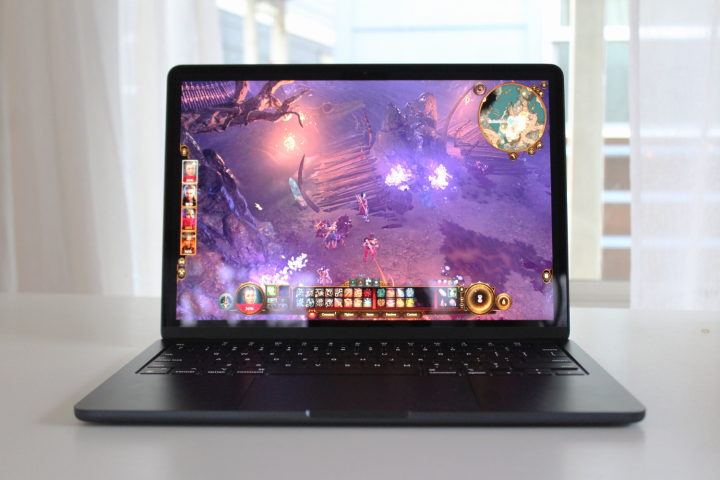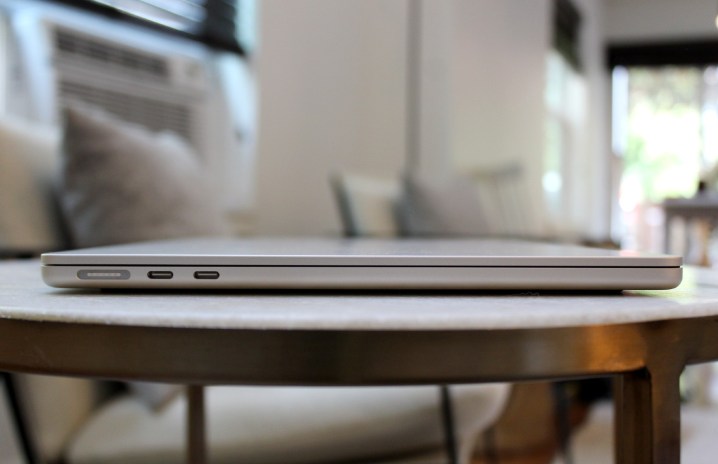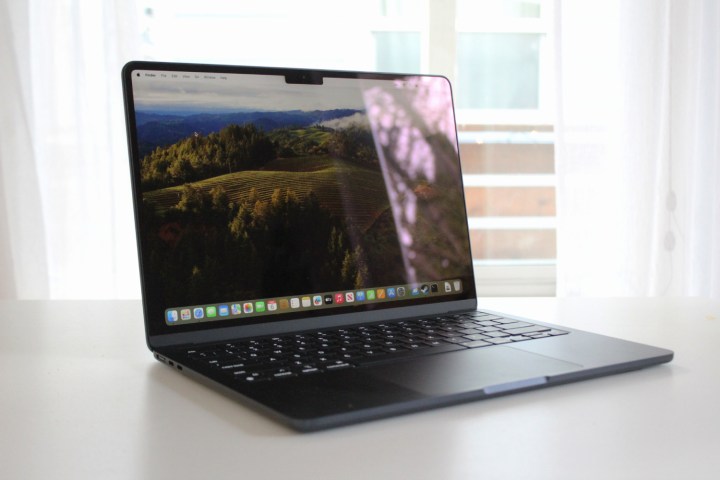
The Apple MacBook Air M3 has ruled the 13-inch laptop market for a while now. Unless you absolutely need Windows, there’s been little reason to choose any other laptop thanks to the MacBook’s build quality, performance, and class-leading battery life.
Asus has long provided some solid competitors, though. In particular, the Zenbook S 13 OLED brings a spectacular OLED display to the fight. It’s a very good laptop as well, but does it have enough to dethrone the MacBook Air?
Specs and configurations
| Asus Zenbook S 13 | Apple MacBook Air M3 | |
| Dimensions | 11.66 inches x 8.52 inches x 0.43-0.46 inches | 11.97 inches x 8.46 inches x 0.44 inches |
| Weight | 2.2 pounds | 2.70 pounds |
| Processor | Intel Core Ultra 7 155U | Apple M3 (10-core) |
| Graphics | Intel Arc | Apple M3 (8-core) Apple M3 (10-core) |
| RAM | 16GB 32GB |
8GB 16GB 24GB |
| Display | 13.3-inch 16:10 2.8K (2880 x 1800) OLED, 60Hz | 13.6-inch 2560 x 1664 IPS, 60Hz |
| Storage | 512GB 1TB |
256GB 512GB 1TB 2TB |
| Touch | No | No |
| Ports | 1 x USB-A 3.2 2 x USB-C 3.2 with Thunderbolt 4 1 x HDMI 2.1 1 x 3.5mm audio jack |
2 x USB-C with Thunderbolt 4 1 x 3.5mm audio jack 1 x MagSafe 3 |
| Wireless | Wi-Fi 6E and Bluetooth 5.3 | Wi-Fi 6E and Bluetooth 5.3 |
| Webcam | 1080p with infrared camera for Windows 11 Hello facial recognition | 1080p |
| Operating system | Windows 11 | macOS Sonoma |
| Battery | 63 watt-hour | 52.6 watt-hour |
| Price | $1,400+ | $1,099+ |
| Rating | 3.5 out of 5 stars | 4 out of 5 stars |
The Asus Zenbook S 13 OLED starts at $1,200 for an Intel Core Ultra 7 155H, 16GB of RAM, a 512GB SSD, and a 13.3-inch 2.8K OLED display. While the laptop can also be purchased with 32GB of RAM and a 1TB SSD in some areas, pricing is currently unavailable in the US.
The MacBook Air M3 comes in a range of configurations, with the base model priced at $1,099 for an 8-core CPU/8-core GPU M3 chipset, 8GB of RAM, a 256GB SSD, and a 13.6-inch IPS display. Various upgrades are available, such as an 8-core CPU/10-core GPU M3 for an extra $100. It’s $200 more for 16GB of RAM and an additional $800 for the maximum 2GB SSD. The fully loaded model with the faster M3, 24GB of RAM, and a 2TB SSD is $2,299. That makes the MacBook Air less expensive at the entry-level, but a lot more expensive at the high end.
Design

These are two very thin laptops, with the ZenBook S 13 coming in at 0.46 inches at its thickest point and the MacBook Air M3 at 0.44 inches. The Zenbook is considerably lighter at 2.2 pounds versus 2.7 points. The MacBook’s bezels are a bit thinner all around, making it just slightly wider, but not as deep, even with its larger display.
The Zenbook S 13 has more angles and a keyboard that props up at an angle, which gives it a slightly sleeker aesthetic than the blockier and less angular MacBook Air. Somehow, though, Apple’s meticulous design comes through and gives the MacBook Air a slightly more elegant appearance. Apple also offers more colors, including Midnight Black, Starlight, Space Gray, and Silver. Nonetheless, both laptops have their charms and you’ll have a great-looking machine no matter which you choose.
In terms of build quality, they’re also on equal footing. In fact, the Zenbook S 13 might be the more rigid laptop given some bendiness in the MacBook Air’s display. While the MacBook is machined from a chunk of aluminum, the Zenbook uses a “plasma ceramic aluminum” material that gives the lid a unique feel. Overall, both laptops feel very well built and robust.
The Zenbook S 13 also has more connectivity, with a mix of modern and legacy ports. The MacBook Air’s one advantage is its MagSafe 3 power adapter that keeps both Thunderbolt 4 ports available for use even when charging. Both have the same level of wireless connectivity.
Both also have 1080p webcams, while the ZenBook S 13 adds in an infrared camera for Windows 11 Hello facial recognition. The MacBook Air has Apple’s Touch ID sensor built into the power button. The ZenBook S 13 can take advantage of the Neural Processing Unit (NPU) built into the Intel Meteor Lake chipset that powers Microsoft’s Studio Effects software, including AI background blurring and other effects. The MacBook Air will be able to take advantage of the AI features coming in macOS Sequoia later this year.
Performance

The Zenbook S 13 OLED uses the 15-watt Intel Core Ultra 7 155U with 12 cores (two Performance, eight Efficient, and two Low Power Efficient) and 14 threads. It’s a chipset aimed at better efficiency for productivity users. The MacBook Air has two chipsets, an 8-core CPU/8-core GPU version and one with 10 GPU cores. It’s also aimed primarily at productivity users, but it has a reasonably fast GPU and CPU optimizations that help speed up various creativity tasks like encoding and decoding video.
Overall, the MacBook Air M3 is faster than the Zenbook S 13 OLED, and it would make for a better entry-level photo- and video-editing laptop. Neither of these machines are very good for gamers.
| Handbrak (seconds) |
Cinebench 2024 (Single/ Multi) |
|
| Asus Zenbook S 13 OLED (Core Ultra 7 155U) |
Bal: 131 Perf: 119 |
Bal: 103 / 409 Perf: 105 / 508 |
| Apple MacBook Air (M3 8/10) |
Bal: 109 Perf: N/A |
Bal: 141 / 601 Perf: N/A |
Display and audio

The Zenbook S 13 OLED’s best feature is right there in its name — its excellent OLED display. It’s sharper at 2880 x 1800 in a 13.3-inch 16:10 display size compared to the MacBook Air’s 13.6-inch, 16:10 2560 x 1664 panel. And of course, when looking at the two side by side, the OLED display’s brilliant colors and inky blacks stand out.
When tested with a colorimeter, the difference is significant. First, the Zenbook S 13 OLED’s display has wider colors at 100% of sRGB, 97% of AdobeRGB, and 100% of DCI-P3 compared to the MacBook Air’s display at 100%, 87%, and 99%, respectively. The Zenbook’s color accuracy is also better at a DeltaE of 1.12 versus 1.24 for the MacBook Air. And the Zenbook’s contrast is nearly infinite, measuring at 27,180:1 compared to 1,480:1. The only metric where the MacBook Air’s display is better is brightness, at 495 nits versus 391 nits.
The MacBook Air M3 has a very good IPS display. But the Zenbook S 13 OLED’s panel is a lot better.
The MacBook Air also has a much better 4-speaker audio system that delivers more volume and clearer sound than the Zenbook’s 2-speaker setup.
Portability

Both laptops are very portable, with the Zenbook S 13 OLED winning based on its half-pound lower weight.
More impressive is the MacBook Air M3’s phenomenal efficiency. It lasted 19 hours in both our web-browsing and video-looping battery tests, while the Zenbook went for 8.75 hours and 12.5 hours, respectively. The MacBook Air also lasts longer when running more demanding tests.
Ultimately, if battery life matters, then the MacBook Air is your best choice for a small laptop.
The Zenbook S 13 OLED puts up a good fight
The Zenbook S 13 OLED is among the best 13-inch Windows laptop you can buy right now. It’s very well built, fast enough for demanding productivity users, has an attractive and solid build, and its battery life is decent. It’s even one of the very few Windows laptops that is portable enough to compete with the MacBook Air. You can’t ignore that brilliant OLED screen either. If you want a MacBook Air competitor on the Windows side, the Zenbook S 13 is one of the very best.
But comparing it directly with the MacBook Air M3, it must be said that the latter is faster and gets significantly better battery life. It’s hard to beat the efficiency of Apple’s Silicon chipsets, and considering the two are very close in price, the MacBook Air M3 gets the overall win.
Services Marketplace – Listings, Bookings & Reviews
